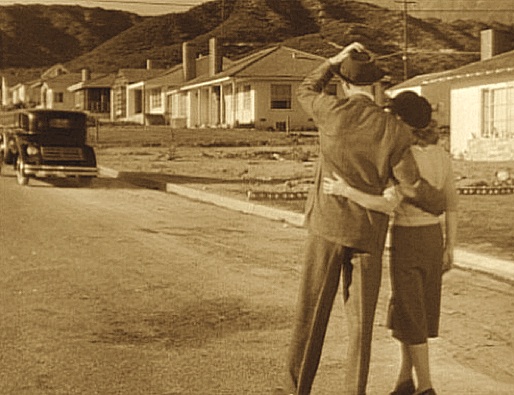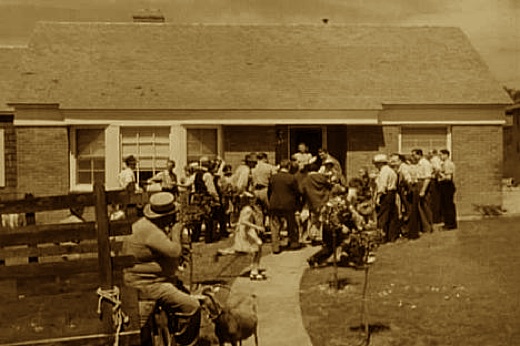SUBHEAD: There are lessons in life, finance and urban design to be learned from "It's A Wonderful Life"
By LLoyd Alter on 24 December 2012 for TreeHugger -
(http://www.treehugger.com/urban-design/are-there-lessons-life-finance-and-urban-design-be-learned-its-wonderful-life.html)

Image above: Scene of suburban Baily Park in "It's A Wonderful Life". From (http://www.flickr.com/photos/cinephobia/3661485622/in/photostream/).
Over at Wise Bread, a frugal living website, Julie Rains lists a number of lessons that one can learn from the film "It's a Wonderful Life." I am not sure she gets it right; George made a lot of mistakes, almost loses everything and only survived the event because his plastic-making war-profiteering University buddy, Sam Wainwright, bailed him out at the last moment on Christmas Eve. I wrote about this in 2006, pre-housing crash, wondering why everyone thought it was such a wonderful life, taking people's money to build suburbs.
George made his money by building suburban houses in a Levittown-like Bailey Park, where the houses are far apart and the street allowance looks about 300 feet wide. Here he is giving a lift to the Martini family, who are leaving a dense, racially mixed and multicultural community. Mr. Martini could probably walk to his restaurant from there.

Image above: Scene of Mr. Martini moving into Baily Park. From (http://www.flickr.com/photos/cinephobia/3661485622/in/photostream/).
In Bailey Park, Mr. Martini has a lovely detached house, On moving in George gives him bread, so he will never know hunger, salt so that life will always have flavour and wine, that joy and prosperity may reign forever. but what about gas? How will he get to work? Mr. Martini will now have to feed a car as well as a family.
Of course George built the houses for Joe and the Kennedys and Mrs. Maitland with money he got from depositors , sliced and diced them up and gave them notes as security, but that didn't stop them from demanding their money back from a bank so under-capitalized that it couldn't cover a four thousand dollar error. Talk about living on the edge.
Meanwhile, like all bankers and developers, he spends his money on a big old drafty house that keeps his wife working day and night just to hold together.
In the end, Bailey gets Bailed out; bankers always do, and the opportunity to turn Bedford Falls into the thriving hotspot that Mr. Potter envisioned, with tourists and restaurants and music and dancing, is lost. Gary Kamiya described it:
Sorry, Julie at Wise Bread, if there are any financial lessons to be learned from "It's a wonderful life", you are not going to learn them from George Bailey.
.
By LLoyd Alter on 24 December 2012 for TreeHugger -
(http://www.treehugger.com/urban-design/are-there-lessons-life-finance-and-urban-design-be-learned-its-wonderful-life.html)

Image above: Scene of suburban Baily Park in "It's A Wonderful Life". From (http://www.flickr.com/photos/cinephobia/3661485622/in/photostream/).
Over at Wise Bread, a frugal living website, Julie Rains lists a number of lessons that one can learn from the film "It's a Wonderful Life." I am not sure she gets it right; George made a lot of mistakes, almost loses everything and only survived the event because his plastic-making war-profiteering University buddy, Sam Wainwright, bailed him out at the last moment on Christmas Eve. I wrote about this in 2006, pre-housing crash, wondering why everyone thought it was such a wonderful life, taking people's money to build suburbs.
George made his money by building suburban houses in a Levittown-like Bailey Park, where the houses are far apart and the street allowance looks about 300 feet wide. Here he is giving a lift to the Martini family, who are leaving a dense, racially mixed and multicultural community. Mr. Martini could probably walk to his restaurant from there.

Image above: Scene of Mr. Martini moving into Baily Park. From (http://www.flickr.com/photos/cinephobia/3661485622/in/photostream/).
In Bailey Park, Mr. Martini has a lovely detached house, On moving in George gives him bread, so he will never know hunger, salt so that life will always have flavour and wine, that joy and prosperity may reign forever. but what about gas? How will he get to work? Mr. Martini will now have to feed a car as well as a family.
Of course George built the houses for Joe and the Kennedys and Mrs. Maitland with money he got from depositors , sliced and diced them up and gave them notes as security, but that didn't stop them from demanding their money back from a bank so under-capitalized that it couldn't cover a four thousand dollar error. Talk about living on the edge.
Meanwhile, like all bankers and developers, he spends his money on a big old drafty house that keeps his wife working day and night just to hold together.
In the end, Bailey gets Bailed out; bankers always do, and the opportunity to turn Bedford Falls into the thriving hotspot that Mr. Potter envisioned, with tourists and restaurants and music and dancing, is lost. Gary Kamiya described it:
Pottersville offers a rich variety of nightlife and entertainment. There is something for every taste and every budget. Pool and billiards sharpen hand-eye coordination. Dime-a-dance joints promote bonhomie. Prize fights and strip clubs provide weary citizens with much-needed catharsis. ..And, of course, there are the town’s many fine taverns. Alas, we will never know what delights are hidden behind the door of the Indian Club or the Bamboo Room, the Midnight Club or the Blue Moon.Like so many New England mill towns that thrived on water power, Bedford Falls needed revitalization, a new commercial raison d'etre. And what did George Bailey give it? Real estate development in the 'burbs.
Sorry, Julie at Wise Bread, if there are any financial lessons to be learned from "It's a wonderful life", you are not going to learn them from George Bailey.
.
No comments :
Post a Comment